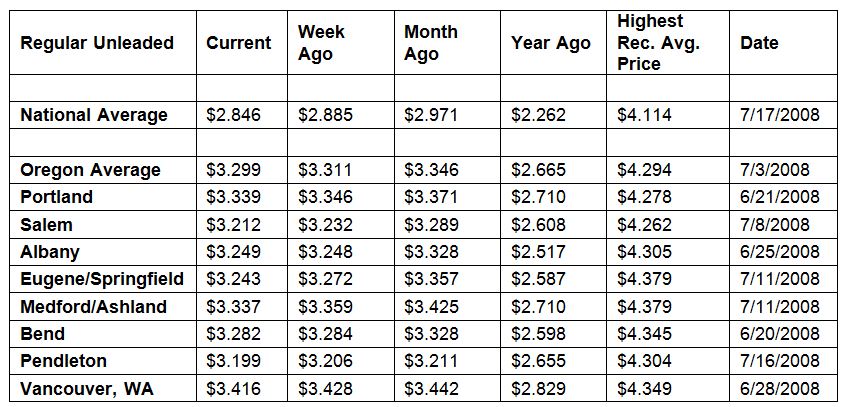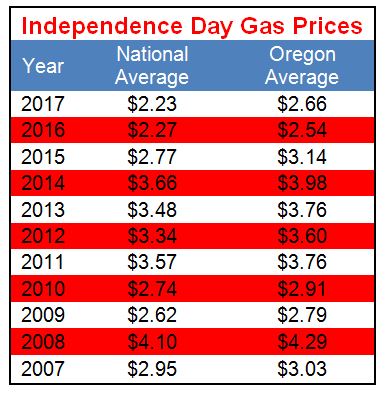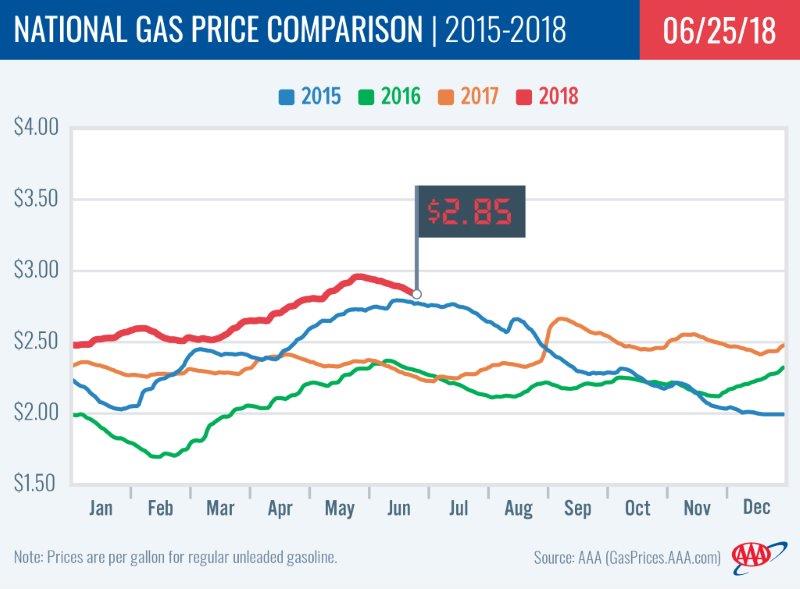PORTLAND, Ore., – Gas prices are ticking down ahead of the Independence Day holiday with 48 states showing decreases this week. The national average for regular loses four cents to $2.85 a gallon. The Oregon average slips a penny to $3.30. Despite the decreases, pump prices are around 60 cents a gallon more than a year ago.
Pump prices have been moving lower since Memorial Day. The national average has lost 12 cents since then while the Oregon average has fallen a nickel.
AAA projects a record-breaking 46.9 million Americans (14.3 percent of the population) will travel 50 or more miles away from home this Independence Day holiday, the highest travel volume for the holiday since AAA started tracking 18 years ago and a 5.3 percent increase compared to last year.
In the Pacific Region, (AK, CA, HI, OR, WA), 7.2 million are expected to travel, up 5.4 percent compared to last year. In Oregon, roughly 555,000 people are expected to take a 4th of July getaway.
Find the AAA Independence Day Travel Projections here.
Gas prices may fall even more following OPEC’s announcement that the cartel will increase production by one million b/d in the second half of 2018. However, that number may be revised closer to 600,000 b/d, as there is speculation that some producers – including Libya, Venezuela and Iran – will not be able to meet that increase. Regardless, the increased oil production is expected to send crude prices lower and in turn drive down gas prices later this year.
“U.S. drivers will not see lower pump prices in the short term due to the OPEC production boost. Rather, it will impact pump prices in late summer or early fall, and changes are not expected to be dramatic,” says Marie Dodds, public affairs director for AAA Oregon/Idaho.
The cartel made the production decision after the U.S., China and India voiced support for an increase to prevent an oil deficit that could stifle economic growth in the latter half of 2018. The production increase will occur ahead of this December’s expected dissolution of OPEC’s production reduction agreement, which has worked to reduce global oil supplies and increase the global price of crude since the beginning of 2017.
Oregon is one of 48 states and the District of Columbia reporting week-over-week decreases. The largest decreases are in Michigan (-13 cents) and Indiana (-6 cents). The only two states reporting weekly increases are Wyoming (+2 cents) and Hawaii (+1 cent). This week 12 states have averages at or above $3 a gallon, down from 14 last week.
Oregon is one of 43 states and the District of Columbia where prices are lower than one month ago. The national average is 13 cents less and the Oregon average is a nickel less than a month ago. Oregon has the 42nd-largest monthly decrease in the country. Michigan (-25 cents) has the largest monthly increase, while Wyoming (+6 cents) has the largest monthly increase.
The West Coast continues to have the most expensive gas prices in the nation. Hawaii is most expensive for the third week in a row with California, Washington, Alaska, Oregon and Nevada rounding out the top six. Oregon moves back up to fifth after a week at sixth.
| Rank | Region | Price on 6/26/18 | |
| 1 | Hawaii | $3.74 | |
| 2 | California | $3.67 | |
| 3 | Washington | $3.44 | |
| 4 | Alaska | $3.40 | |
| 5 | Oregon | $3.30 | |
| 6 | Nevada | $3.28 | |
| 7 | Idaho | $3.17 | |
| 8 | Utah | $3.17 | |
| 9 | Connecticut | $3.09 | |
| 10 | Arizona | $3.05 |
According to the U.S. Energy Information Administration’s (EIA) petroleum report for the week ending on June 15, gasoline stocks in the West Coast region fell by 600,000 bbl and now sit at 30.9 million bbl. However, inventories are 1.7 million bbl higher than they were at this point last summer, which will likely help prices stabilize if there are any major supply disruptions in the region this week.
The nation’s cheapest markets are South Carolina ($2.50) and Mississippi ($2.54). For the 47th week in a row, no states have an average below $2.
Drivers in all 50 states and the District of Columbia are paying more than a year ago to fill up. The national average is 58 cents more and the Oregon average is 63 cents more than a year ago. This is the 8th-largest yearly increase in the country. Arizona has the greatest year-over-year increase of 77 cents; California is second at 71 cents; New Mexico is third at 70 cents, and Hawaii is fourth at 69 cents.
Oil Market Dynamics
Oil prices will likely remain volatile this week as markets digest OPEC’s announcement and analyze the potential impacts. On the domestic crude front, EIA’s report last week revealed that total crude inventories in the country decreased by 5.9 million bbl. Moreover, total crude exports hit their second highest rate since EIA began collecting this data at 2.4 million b/d. The rate was an increase of 344,000 b/d from the previous week. These findings highlight that domestic and global demand for crude from the U.S. remains high as OPEC works to increase the amount it supplies around the world.
In other news, the U.S. lost one oil rig last week, according to Baker Hughes, Inc., bringing the total number of rigs to 862. However, there are still 104 more rigs now than a year ago at the same time.
At the close of Friday’s formal trading session on the NYMEX, WTI increased $3.04 to settle at $68.58. At the close of Monday’s formal trading session on the NYMEX, WTI lost 50 cents to settle at $68.08. Today crude is trading around $70, compared to $65 a week ago. Crude prices are up about five percent in the last month and are about $25 more per barrel than a year ago.
Drivers can find current gas prices along their route with the free AAA Mobile app for iPhone, iPad and Android. The app can also be used to map a route, find discounts, book a hotel and access AAA roadside assistance. Learn more at AAA.com/mobile.
Diesel
For the week, the national average slips two cents to $3.16 a gallon. Oregon’s average adds half a cent to $3.43. A year ago the national average for diesel was $2.45 and the Oregon average was $2.66.
Find current fuel prices at GasPrices.AAA.com.
AAA news releases, high resolution images, broadcast-quality video, fact sheets and podcasts are available on the AAA NewsRoom at NewsRoom.AAA.com.




